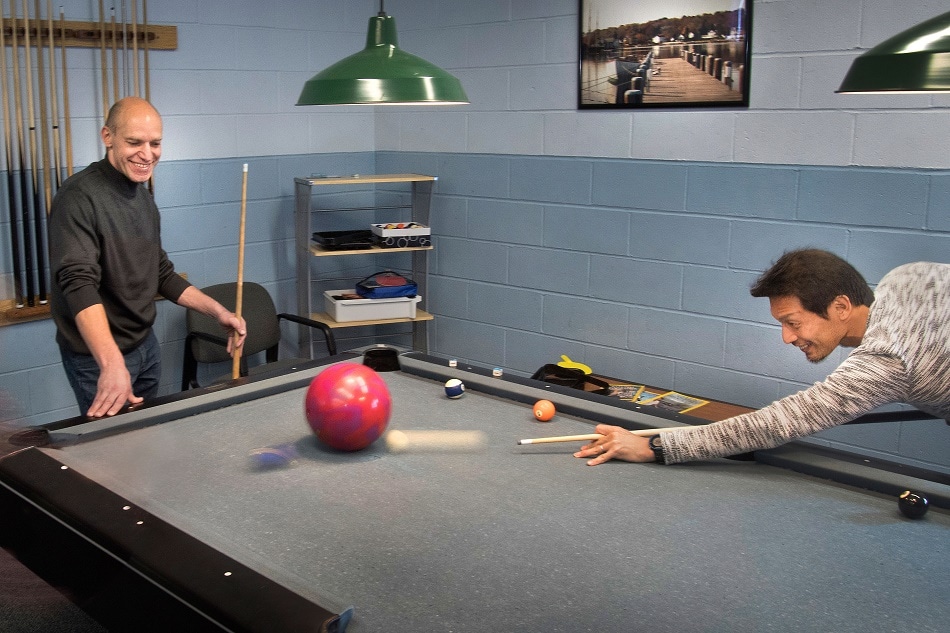 Physicists in America are using billiards and a bowling ball to demonstrate the unexpected results obtained while investigating the spin of different sized nuclei. Their work may offer new insight into the mechanisms affecting particle production in proton-ion collisions.
Physicists in America are using billiards and a bowling ball to demonstrate the unexpected results obtained while investigating the spin of different sized nuclei. Their work may offer new insight into the mechanisms affecting particle production in proton-ion collisions.
Physicists in America are using billiards and a bowling ball to demonstrate the unexpected results obtained while investigating the spin of different sized nuclei. Their work may offer new insight into the mechanisms affecting particle production in proton-ion collisions.
"What we observed was totally amazing," said Alexander Bazilevsky, deputy spokesperson for the PHENIX collaboration at Relativistic Heavy Ion collider (RHIC) at Brookhaven National Laboratory. "Our findings may mean that the mechanisms producing particles along the direction in which the spinning proton is traveling may be very different in proton-proton collisions compared with proton-nucleus collisions."
Physicists conducted experiments which saw spinning protons striking different sized atomic nuclei in the RHIC - the only collider in the world with the ability to precisely control the spin direction of colliding protons. They discovered neutrons produced when a spinning proton collides with another proton come out with a slight rightward-skew. But when the spinning proton collides with a much larger nucleus – that of gold - the neutrons' directional preference becomes larger and switches to the left.
Understanding different particle production mechanisms could have massive implications for interpreting other high-energy particle collisions, including those of ultra-high cosmic rays with particles in the Earth’s atmosphere, Bazilevsky added.
In 2001-2002, during RHIC's first polarized proton experiments, physicists observed neutrons tended to emerge slightly to the right in proton-proton interactions. A hypothesis developed by theoretical physicists explained the result, but gave scientists no reason to expect such a strong directional preference when protons collided with larger nuclei, let alone a complete flip in the direction of that preference.
We anticipated something similar to the proton-proton effect, because we couldn't think of any reasons why the asymmetry could be different. Can you imagine why a bowling ball would scatter a cue ball in the opposite direction compared with a target billiard ball?
Itaru Nakagawa, RIKEN Physicist and PHENIX's Deputy Run Coordinator for Spin Measurements in 2015
RHIC began colliding protons with gold nuclei at high energy in 2015 – the first such collisions anywhere in the world. Minjung Ki, a graduate at Seoul National University and the RIKEN-BNL Research Center at Brookhaven Lab, first noticed the dramatic skew of the neutrons and that the directional preference was opposite to that of proton-proton collisions. Bazilevsky worked with Ki on data analysis and detector simulations to confirm the effect and Nakagawa collaborated with accelerator physicists on experiments to repeat the measurements under even more precisely controlled conditions.
The new measurements – which also include results from collisions of protons with intermediate-sized aluminium ions - demonstrated the effect was real and that it changed with the size of the nucleus.
We have three sets of data - colliding polarized protons with protons, aluminium, and gold. The asymmetry gradually increases from negative in proton-proton - with more neutrons scattering to the right - to nearly zero asymmetry in proton-aluminium, to a large positive asymmetry in proton-gold collisions - with many more scatterings to the left.
Alexander Bazilevsky, Deputy Spokesperson for the PHENIX Collaboration, Relativistic Heavy Ion collider (RHIC), Brookhaven National Laboratory
To fully understand the findings, the scientists closely analyzed at the processes and forces affecting the scattering particles.
"In the particle world, things are much more complicated than the simple case of (spinning) billiard balls colliding," Bazilevsky explains. "There are a number of different processes involved in particle scattering, and these processes themselves can interact or interfere with one another."
In the case of large nuclei like gold, the basic idea is that electromagnetic interactions play a greater role in particle production than they do when two small, equally charged protons collide.
"In the collisions of protons with protons, the effect of electric charge is negligibly small," said Nakagawa, who led the theoretical interpretation of the experimental data. Here, the asymmetry is driven by interactions governed by the strong nuclear force, but as the size - and charge - of the nucleus increases, the electromagnetic force takes on a larger role and, at a certain point, flips the directional preference for neutron production.
The scientists will continue to study the 2015 data to see how the effect depends on variables such as the momentum of the particles in various directions, and analyze how preferences of particles other than neutrons are affected, working with theorists to better understand their results.
Another idea would be to execute new experiments colliding polarised protons with other kinds of nuclei not yet measured.
"If we observe exactly the asymmetry we predict based on the electromagnetic interaction, then this becomes very strong evidence to support our hypothesis," Nakagawa said.
Disclaimer: The views expressed here are those of the author expressed in their private capacity and do not necessarily represent the views of AZoM.com Limited T/A AZoNetwork the owner and operator of this website. This disclaimer forms part of the Terms and conditions of use of this website.